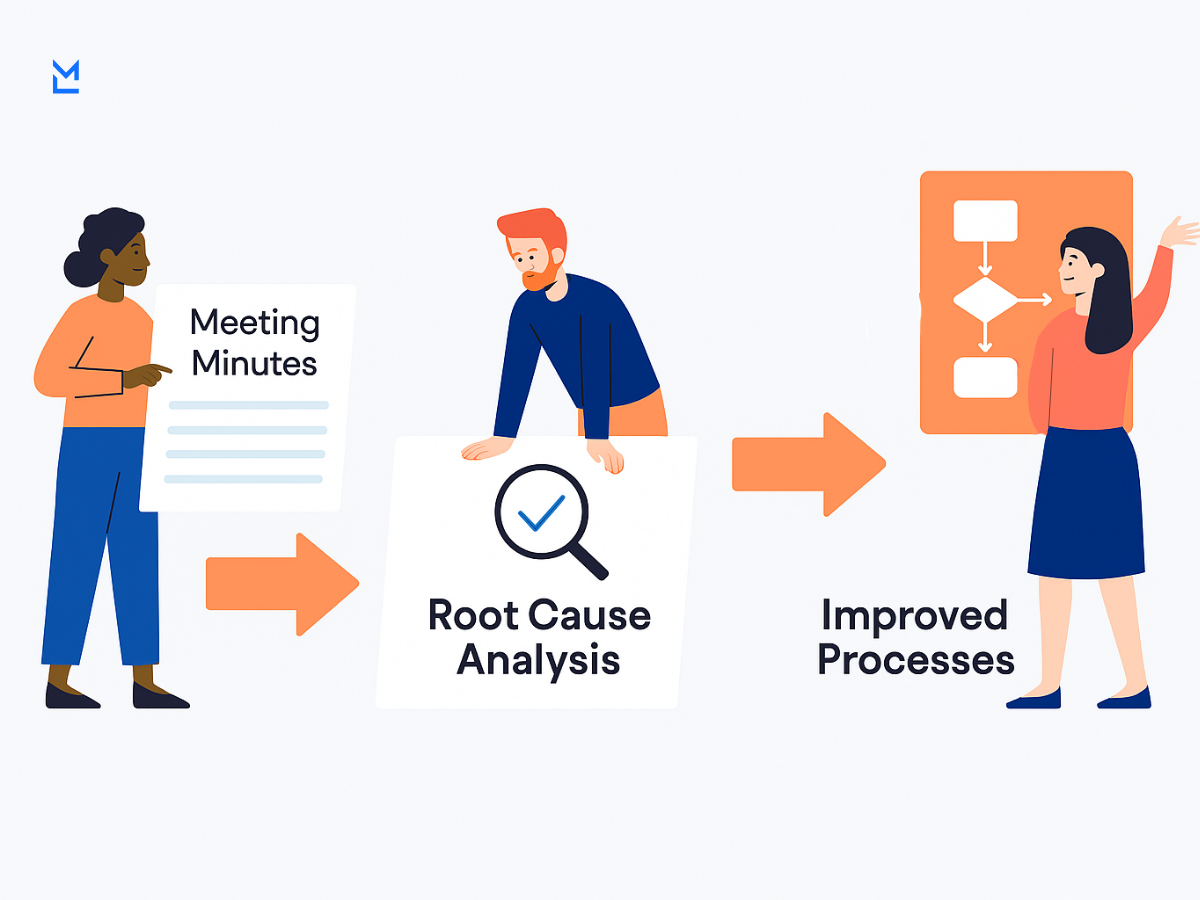
Written with help from MinutesLink - free AI meeting notetaker for online meetings.
Written with support from MinutesLink — a free AI notetaker for online meetings.
Every organisation talks about saving money and optimising business processes but very few actually track how decisions turn into financial outcomes. Most companies rely on intuition not documentation. And ironically it’s the simplest tool - meeting minutes - that turns messy conversations into a strategic plan with measurable performance metrics.
Meeting minutes do more than summarise a meeting. They record key elements of decisions, the person responsible for each action plan and the specific tasks needed to move projects forward. When teams use them consistently they can reduce human error, track progress in existing processes and prevent manual effort that drains both time and resources.
This isn’t just about writing notes. It’s about documenting processes in a way that reveals root causes, identifies areas for improvement and supports continuous process improvement that has real financial impact.
Here’s something business leaders rarely say out loud: unclear communication is expensive. When teams misunderstand tasks, skip steps or duplicate effort the cost doesn’t always show up immediately - but it always shows up.
Clear documentation reduces these losses. Meeting minutes store decisions, timelines, end dates, available resources and necessary adjustments all in one place. That alone eliminates confusion, reduces delays and helps project managers avoid costly bottlenecks.
And the more complex the work - from software development to human resources to marketing - the more important this becomes. When teams write meeting minutes that include action plans, performance metrics and version control they create a structure that directly supports cost savings across various industries through effective process improvement.
To understand the financial impact you first need to understand how meeting minutes shape processes. Every decision, every small change, every clarified responsibility improves processes over time. Meeting minutes reveal root causes behind repeated mistakes. They help teams identify areas where processes break down. They make it easier to allocate resources effectively. They reduce human error by clearly defining specific steps, specific tasks and individual tasks. This is the essence of continuous improvement - and improved processes always reduce costs.

Process mapping becomes easier. The PDCA cycle becomes clearer. Total quality management becomes more actionable. Even small-scale operations benefit because improved processes reduce manual effort and unnecessary rework. All these are key components of effective process improvement.
An action plan is the difference between a good discussion and real progress. When meeting minutes include clear action steps, deadlines and a person responsible they turn vague ideas into real deliverables. And when organisations use action plans consistently they create action plans that live inside their workflow tracking system instead of being forgotten after the meeting.
Good action plans define steps involved, identify potential bottlenecks, assign tasks and make project plans easier to follow. They also ensure the team understands project goals, specific goals and how to allocate resources wisely. This structured approach is fundamental to successful process improvement.
Over time well-written action plans contribute to cost savings because they reduce human error, increase productivity and keep business processes aligned with organisational goals.
Workflow tracking isn’t just a productivity technique - it’s a financial protection mechanism. When you track progress consistently you ensure that tasks align with the strategic plan and that people actually complete the work they committed to.
Meeting minutes are one of the best tools for workflow tracking because they document each task, each due date and each person responsible for execution. They show how the meeting progresses over time and provide future reference for complex discussions.
Without workflow tracking teams rely on memory. And memory creates lost actions, duplicated processes and wasted resources - all of which increase costs. Effective workflow tracking is a core part of continuous process improvement.
Most companies don’t realise how much they overspend simply because they don’t connect decisions to measurable results. When meeting minutes document decisions and tie them to performance metrics cost savings become visible.

Let’s say a team decides to streamline processes or implement new processes. Meeting minutes can record what the change is supposed to achieve, which resources are required and how the decision will be measured through financial statements or project goals.
This turns guesswork into data. And when data guides decision making cost savings happen not by accident but by design. This is the power of process improvement in action.
Here’s where organisations start to see real change. When teams use a tool that reduces manual effort, improves document storage and supports version control, their whole process changes.
Minuteslink helps teams focus on business not paperwork. It reduces human error, makes writing meeting minutes faster and offers online sharing so everyone is aligned. Suddenly meeting minutes are something people actually use instead of something they ignore.
With Minuteslink improved processes happen naturally because the tool handles both the structure and the workflow tracking for real cost savings and process improvement.
Continuous improvement only happens when processes are visible. Meeting minutes reveal root causes, make project plans easier to update and show which steps need attention. This way teams can improve processes with clarity not react blindly.
When teams document processes consistently they create a system that supports both continuous improvement and continuous process improvement. They also get a clear view of how changes affect customer satisfaction, human resources coordination and business processes at every level.
This documentation becomes even more powerful when paired with lean manufacturing, six sigma thinking or total quality management - all of which rely on structured, reliable, human readable data and support effective process improvement.
Every improved process saves costs. Sometimes the savings are obvious - less wasted time, fewer errors, faster delivery. Sometimes the savings show up in the background - smoother communication, fewer bottlenecks, more effective use of resources.
When teams use meeting minutes to document processes they avoid unnecessary changes, reduce rework and ensure one task doesn’t get forgotten or left undone.

These savings show up in financial statements and project timelines. Over time organisations build stronger systems that support cost savings across multiple departments through ongoing process improvement.
Project management thrives on clarity. Meeting minutes clarify the project plan, define specific steps and help project managers track progress. They support organisational goals, make business leaders more confident in their decisions and help teams stay aligned in fast paced environments.
When project managers use written meeting minutes instead of scattered memory they reduce risk, improve communication and create consistent structures for project plans across industries. This clarity is essential for effective process improvement.
It may sound boring but document storage and version control are two of the biggest contributors to cost savings. When documents get lost, duplicated or overwritten teams lose valuable data - and they lose time recreating it. Meeting minutes solve this by storing decisions, steps and references to speaker documents in one place. With organized document storage teams reduce chaos. With version control they ensure everyone uses the latest information.
This is where digital tools including Google Docs, Microsoft Word and platforms designed for collaboration come in. They keep meeting minutes accurate and accessible for future reference, supporting continuous process improvement.
As teams grow documentation grows with them. Using a tool like Minuteslink reduces manual effort, maintains version control and aligns team members with real-time updates. It turns writing meeting minutes into a habit not a chore.

Minuteslink supports document storage, collaboration, online sharing and action plans making it much easier to keep processes aligned and track progress over time. This translates into cost savings, clearer communication and fewer expensive mistakes, driving ongoing process improvement.
Saving money isn’t always about cutting costs. Often it starts with documenting decisions, processes and action plans in a way that improves clarity and reduces human error. Meeting minutes turn conversations into business value. They help teams identify root causes, align action plans and support continuous improvement.
When organisations document processes consistently they strengthen business processes, create systems for long term success and protect themselves from financial waste.
Real cost savings come not just from big decisions but from the everyday habit of writing clear, structured human meeting minutes that support effective process improvement.
An action plan exists to turn ideas into real results. It’s the bridge between what the team talked about and what actually gets done.
A good action plan breaks a goal into clear steps, assigns responsibilities, sets deadlines, and outlines the resources needed.
In business, action plans reduce confusion, prevent delays, and make progress visible. They’re especially valuable for cost savings because they keep teams aligned and accountable - so decisions don’t dissolve the moment the meeting ends.
Writing meeting minutes isn’t about recording every word. It’s about capturing the essence of the conversation so your team doesn’t lose track of important decisions.
Start with the basics: agenda topics, attendees, and the key outcomes of each discussion point. Then add action items, deadlines, and responsible owners.
The best minutes are clear, human, and easy to skim. Tools like Minuteslink help by automating the rough draft and giving you a structured foundation, so you can focus on accuracy and context instead of formatting everything from scratch.
Process improvement is the ongoing effort to make workflows smoother, faster, and less expensive. It’s about observing how work actually happens, identifying waste or bottlenecks, and adjusting processes so the team can operate more efficiently.
Sometimes it means small tweaks; sometimes it means redesigning entire workflows. Either way, process improvement is a continuous commitment to better performance, higher quality, and fewer unnecessary steps.
Cost savings are calculated by comparing how much a process used to cost versus how much it costs after improvements.
This can include less time spent on tasks, fewer errors, lower labor costs, or reduced rework. A common formula is:
Cost Savings = (Old Cost – New Cost) ÷ Old Cost × 100%
But real cost savings often come from avoided problems - like preventing duplicated work or eliminating inefficient steps. Meeting minutes support accurate cost-savings tracking because they document decisions, expectations, and measurable outcomes.
Workflow tracking keeps work transparent. Everyone sees who’s doing what, what’s already completed, and where tasks might be stuck. When teams track workflows consistently, there’s less confusion, fewer missed deadlines, and much smoother collaboration.
It’s also a powerful driver of cost savings because it prevents the chaos that leads to wasted time. Combined with strong meeting minutes and clear action plans, workflow tracking turns teams into predictable, high-performing systems.